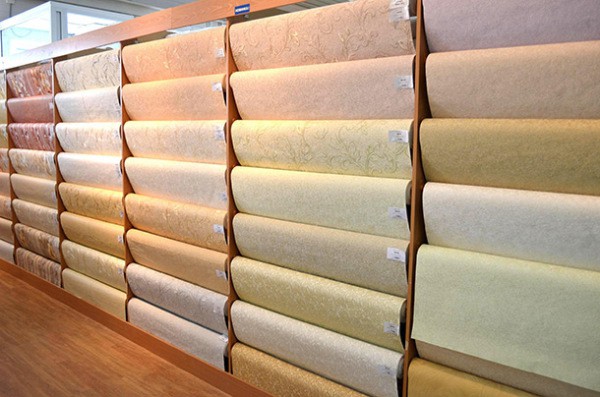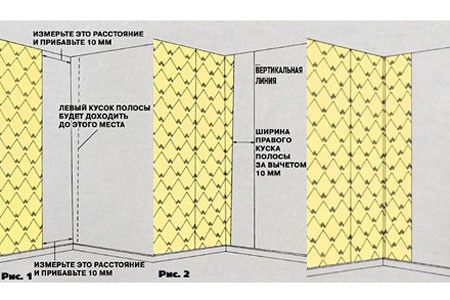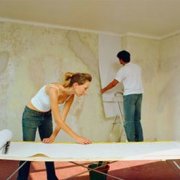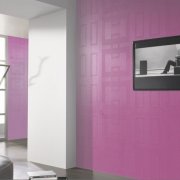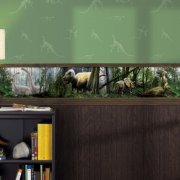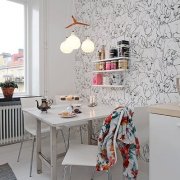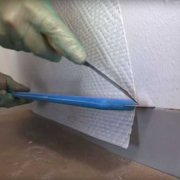How to glue meter non-woven wallpaper correctly
How to glue non-woven meter wallpaper we will look at in detail today. Although it’s worth mentioning right away that a meter is not the largest size. Although such ones are sometimes problematic to glue, especially if there is no one to help.
Today we will look at how to glue non-woven wallpaper and how to do it right. Also in the video and photo below you will also find useful information that will help you in doing this work.
The content of the article
Varieties of wide wallpapers
Wallpaper products in Russia are manufactured according to a single standard, the width of such wallpaper is 53 centimeters. Speaking of wallpaper of foreign manufacture, their range is much larger, and the width itself is non-standard.
A striking example is the wallpaper from Germany or Italy, of which there are so many in our stores now, their width can be as much as 106, so 70 centimeters.
Attention: In addition, you need to pay attention to the wallpaper of a special size. Such products are mainly produced by Belgian wallpaper companies. The width of such wallpapers can vary from 90, 100 centimeters right up to 140. If we talk about French wallpapers, then their width is 90 or 70 centimeters.
After you have decided on the width of the wide wallpaper, you need to understand the technology of gluing.
Here you need to consider the following nuances:
- Firstly, often wide wallpapers are non-woven wallpapertherefore it is not necessary to impregnate with glue.
- Secondly, wide wallpapers are glued quickly and simply, it is enough just to spread a prepared wall and just attach a dry piece of wallpaper to it.
- Thirdly, special attention will have to be paid to aligning and removing air from under the wallpaper.
- Fourth, wallpaper can be not only non-woven, but also paper, but here is a slightly different technology for pasting. Each case must be approached individually.
What are the benefits of wide wallpapers?
The most important advantage is the fewer seams on the wall, the so-called "seamless" effect.
However, in addition to this, there are several indisputable advantages:
- Simplified and quick gluing procedure.
- In addition to saving time, there is a saving of money. Agree, to buy one roll of wide wallpaper will be cheaper than two rolls of ordinary. In order to save as much as possible, you need to correctly calculate how many rolls you need. When calculating it is important not to forget about the material, which will go to allowances and hard to reach places. Just not forgetting about all these points, you can correctly calculate the desired footage of wallpaper.
Now let's see what disadvantages non-standard wallpapers have:
- As such, there are no minuses, but there are small inconveniences. To avoid these inconveniences, you just need to prepare the surface where the wallpaper will be glued (see.Preparing the walls for wallpapering: do it yourself) Otherwise, if you do not align the walls, there can be no talk of high-quality and even wallpapering.
- Therefore, the preparation of the basis for future work is a very important part, since this is a kind of foundation on which the wallpaper will be held. And therefore, this stage of the work must be performed as qualitatively as possible.
- The second inconvenience is that you have to buy an additional roll of wallpaper, as sometimes it happens that you need to glue due to the fact that the length of the wallpaper may not coincide with the long wall. But this is normal, and it also happens with standard wallpapers. Thus, a slight overspending of materials is possible, therefore, considering the footage of the wallpaper.
- The third small inconvenience can be called that wide wallpapers are most conveniently glued with an assistant, since it will be very difficult for one, and then the quality can suffer. All this is because the canvas itself is wide, so one should hold it, and the second should smooth the wallpaper. Only with well-coordinated work is a qualitative result possible, which then will not have to be redone in the near future.
What to look for when choosing wide wallpapers
The most important thing to remember when choosing wide wallpapers is that they will look different in a roll and on a wall. Therefore, it is better to buy wallpaper in specialized stores where images of wallpapers on the stands are presented. Thus, you will see what you choose and how it will look on the wall.
Here are some tips to help you choose a wide wallpaper:
- In order to create an interesting and original design, it is best to buy all the materials from one collection, so everything will look harmonious and beautiful.
- When choosing a wallpaper, always pay a fee for a certificate that will confirm their quality
- Inspecting the booth with samples of wallpaper, begin to look first at the bottom, and then only the middle. As practice shows, most sellers bring to the eye level those items that are not in great demand, but you still need to sell them. And those wallpapers that are cheaper and may look much better, I lower them to the very bottom, or raise them to the very ceiling.
This technique is the most common, so if you remember this, you will not fall for the tricks of the cunning seller who want to sell low-quality goods for a lot of money.
How to prepare the surface for gluing
This is one of the most difficult parts, since the quality of wallpapering depends on its quality.
First of all you need:
- Get rid of the top covers of sockets, switches. For safety, all openings must be covered with adhesive tape, which can be easily removed after pasting.
- Pull all screws, nails from the walls, so that they do not interfere with high-quality and evenly paste the wallpaper.
- Completely clean the walls of the remnants of the old coating. This is very important because even small pieces of the old coating can interfere with the repair. Since the wallpaper may not lie evenly, or the glue will be poorly applied to the wall. In addition, when preparing, you must not forget that it should not have repair dust either.
In houses of the old construction, smooth walls are quite rare. Therefore, here we proceed as follows:
- You just need to smooth the surface with a dry mixture or just simply plasterboard the walls.
- The second option is faster and more reliable. In addition, with the help of drywall you can also make internal thermal insulation, this is especially important when mold occurs on the walls.
Attention: In addition, you need to pay attention to the temperature in the room. During the repair work it is better not to allow, as drafts, and strong air overheating.
Primer walls - an important step in preparing for wallpapering
Smooth walls are a guarantee for a good and high-quality repair, since it is the primer that helps hide numerous chips, bumps and holes in the wall. In addition, for wallpapering on primed walls (seePrimer for wallpaper: which one to choose and how to use) much less glue will leave. If the glue is applied to unprepared walls, then part of the mixture is quickly absorbed, the wallpaper will be very poorly glued.
Attention: A very important point is that before starting the gluing process the primer must dry completely. This is what guarantees a strong adhesion of wallpaper to the wall. If you plan to decorate the room with different foam borders, it is best to do this before the wallpaper is pasted.
Basic Tips for Pasting Wide Wallpapers
First of all, you need to pay attention to whether the purchased glue and wallpaper are compatible, since for each type it is very important which group your wallpaper belongs to. So, they can be: light, dense or heavy. And the wallpaper has its own adhesive mixture, which will guarantee a good, and most importantly high-quality result.
- Using improper glue for wallpaper, you risk not performing high-quality repair work. Usually, in non-standard wallpapers, glue is usually applied directly to the wall, but in order to avoid unpleasant incidents, the instructions should be read immediately.
- Since it is better to be sure that you are doing everything right, than to redo everything in a hurry, in addition, you will spend on remaking not only line materials, but also your time.
How to glue meter non-woven wallpaper so that joints are not striking?
- Firstly, it is best to start gluing from the window and in the direction as the light falls. So, you can make the seams less noticeable.
- Secondly, if the wallpaper has a pattern or patterns, then they must be adhered to. Thus, you can create the effect of a continuous pattern.
- Thirdly, the wallpaper should be glued, starting from the middle and from the top, then the likelihood of a good and accurate pasting will be greater.
Attention: And the last, but a lot of important advice - use a few stepladders for pasting wide wallpapers. So it will be more convenient to glue, well, there will be less body movements and movements.
In general, it should be noted that the process of pasting walls with wide wallpapers is not much different from ordinary wallpapers. And there, and there the most important thing is a well-prepared basis and accurate and thoughtful movements during the sizing of wallpaper itself. It is also very important not only to know the technique of how to properly glue the wallpaper, it is also important to be able to apply all your knowledge into action.
Step-by-step instructions for pasting walls with wide wallpapers
Now let's look at the features of sticking:
- First you need to determine how many strips of wallpaper you need, and for this you need to know the total length of the walls.
- The marking of the first canvas is also very important, as this is the basis for the correct further gluing.
- Particular attention should be paid to wallpapering in the corners. It is always necessary to leave an inlet so that there are no joins and passes, since an ugly gap can form.
- Next, cut the desired number of strips for one wall. After that, you need to apply glue to the entire width of the canvas, slightly beyond the marked lines.
- The best thing is to start wallpapering with an assistant. So, one person holds the upper edge, and the second gently smooths the canvas.
- When smoothing wallpaper to a wall, the main thing is to remove all air bubbles. You need to start from the middle and go to the edges.
- Continuing to glue the wallpaper, you need to do this closely so that there are no gaps and gaps, as this will not look very aesthetically pleasing.
- It is not always possible to guess with the number of whole stripes, so sometimes you have to cut one of them vertically. Further pasting must be continued from the corner, continuing the pattern or drawing. The glue that will protrude at the joints can be removed with an ordinary clean rag.
How to glue wallpaper in uncomfortable places
Wallpapering is not an easy task, especially when it comes to such difficult places as doorways, battery areas or just corners.
- But the ceiling is most conveniently pasted with wide wallpapers. Since all is one, several people are needed for pasting, but less stripes will be needed.Therefore, pasting will be carried out much faster.
- To gently and beautifully glue the wallpaper around and under the battery, it is best to cut the strip of wallpaper into several small pieces. The best option would be to cut from several parts from one canvas.
- The biggest problems with wallpapering in hard-to-reach places arise with the matching of the picture or pattern. It is very difficult to achieve complete coincidence of the pattern. Therefore, all actions must be thought out in advance so as not to lose a lot of material, and most importantly time.
- The huge pole of non-woven wallpaper is that they can be moved for another 10 minutes after the wall sticker. Therefore, do not use quick-drying glue, as you can simply ruin everything. Such glue can be used only by professionals who already have a hand full and they can stick the wallpaper correctly the first time.
How to stick custom wallpapers on your own
Sometimes there are situations when there is no assistant nearby, and you need to glue the wallpaper. This is possible for one person, although many believe that for this process two are needed, since the width of the wallpaper can be about a meter. But the reach of the human hand reaches one and a half meters, so you can glue the wallpaper on your own. The most important thing is to think over all your moves in advance and act quickly.
Even if you can’t perfectly paste the wallpaper on the first try, don’t fall into despair and do not quit work. Since you can always re-glue the canvas, and then repeating this process several times, you will be pulled in and it will start to work out for you.
But the most important thing is not to forget about the technical requirements for wallpapering, because if there is a draft, then you definitely will not succeed. Remember that doors and windows can be opened after a day has passed.
Basic Wall Sticking Tips
At the very end, I would like to draw your attention to a few rules that at first glance may seem simple, but they are very useful and important. Only following these tips will the result of your work exceed all expectations.
So:
- Firstly, try to prepare all the necessary tools in advance so that in the process of pasting you will not be distracted, but only focus on the work. Thus, you will not only not waste time searching for the right tool, but you will be able to fully concentrate on the process.
- Secondly, it is very important to know the technique of pasting walls with wide wallpapers, since then you will have a clear plan for which you will act.
- Thirdly, in addition to the technique, you need to understand how and where to glue. The main thing is to have a ready-made picture in your head, to understand what room you want. In order to make the room look original and stylish, you can use several varieties of wallpaper. Thus, you give the room more expressiveness and texture. This combination of wallpaper is an excellent solution to hide some flaws and bumps in the walls.
An example of such a successful combination of different wallpapers is horizontal alternation. Using this technique, you can visually reduce the height of the room if the ceilings are very high, and with the help of vertical alternation, you can visually expand a narrow room. You can also make a color accent on one wall, it is also very stylish and fashionable.
As a result, it must be said that pasting walls with wide wallpapers has a lot of its nuances and secrets that allow you to quickly and quality wallpaper. How to paste non-woven wallpaper you now understand and the instruction will help you do everything right. And having done everything with your own hands, the final price will not be significant.

